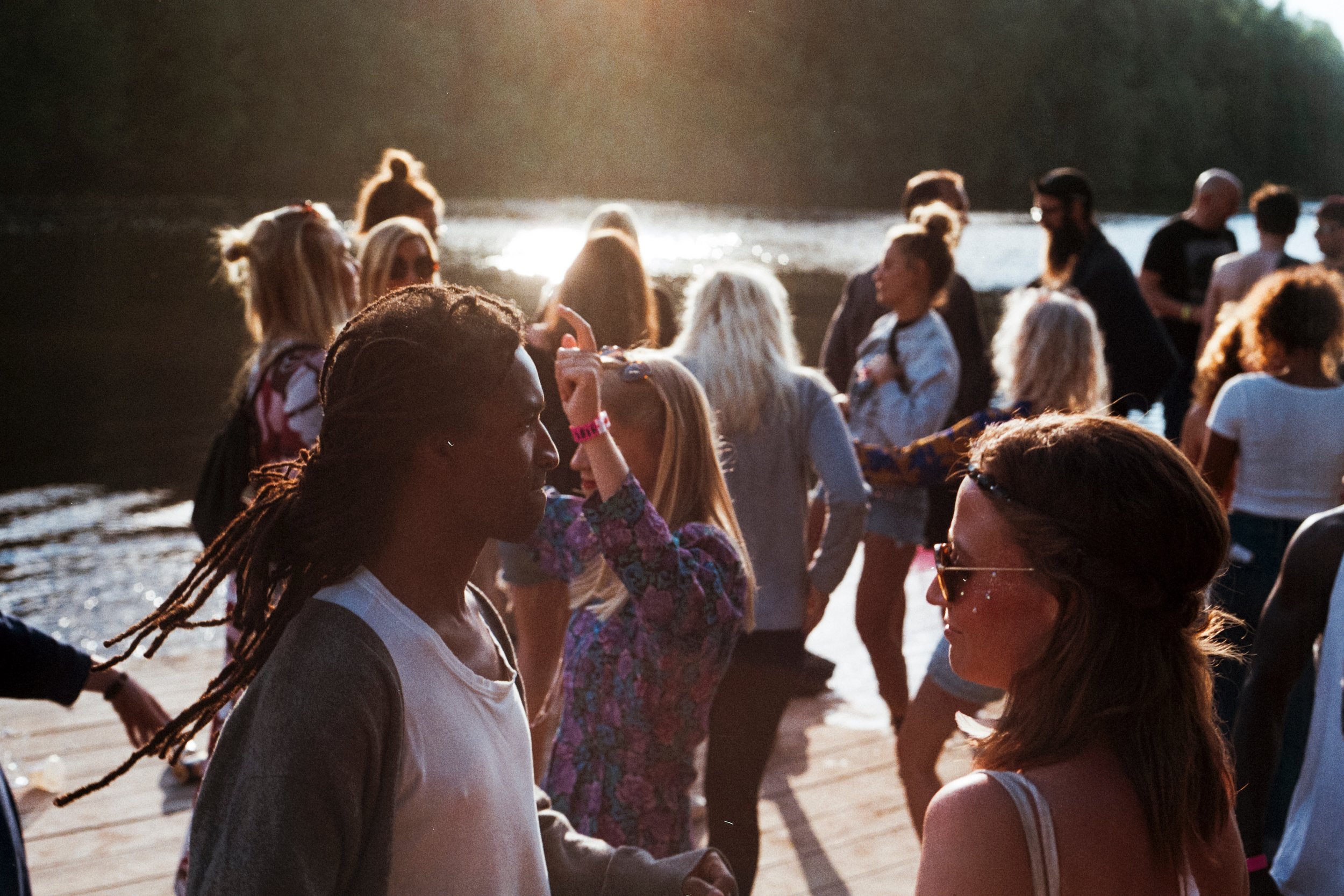How to Create Connection & Belonging at Your Next Gathering
“I believe that everyone has the ability to gather well.
You don’t have to be an extrovert. In fact, some of the best gatherers I know suffer from social anxiety.
You don’t need to be a boss or a manager.
You don’t need a fancy house.
The art of gathering, fortunately, doesn’t rest on your charisma or the quality of your jokes…
Gatherings crackle and flourish when...a host has the curiosity, willingness, and generosity of spirit to try.
”
01. listen to + investigate the spark
It’s easier than you think to gather people. When you have that moment when an idea sparks in your mind, hold onto it and validate it––that’s your heart and intuition telling you there’s a need for some kind of gathering. Most of us let those sparks fade almost as quickly as they came to us because we think we need to create the perfect and, honestly, over-the-top event for people to want to show up.
The truth is, it’s simple: people want to be together; they want to talk; they want to listen; they want to laugh; they even want to get away from their phones and Netflix. If you keep it simple and easy, and put a little thought into it, you’ll find that human connection and belonging will happen.
The more simple it is, the more likely it will actually happen––people will show up and they’ll want to do it again.
02. what are you doing + who needs to be there?
The who and what usually come together the moment you think of an idea. You might think:
• I want to host new neighbors at my home for dinner
• I want to have conversations with people who don’t share the same political values with me
• I want to create a regular gathering for refugees and people in my community to really know each other
• I want to encourage my other male friends to gather together in vulnerable and fun ways
• I want to host mini coffee breaks with my co-workers that help me get to know them
GET SPECIFIC
Who’s it for? You might start out with a dinner for neighbors. But you have a lot of neighbors. Drill down and think about more niche categories:
• new neighbors
• neighbors who love literature
• neighbors who I’ve never met
• neighbors who live alone
• neighbors who have a sign on their lawn that I disagree with
• neighbors who walk their dog every morning/evening
As you get more specific, you’ll be able to quickly put together a guest list that will be meaningful, and give you a good start on the path to connection.
HOW MANY GUESTS?
How deep do you want to connect? Sometimes we want to really get to know someone; other times we just want to be around people in a collective joy moment without having to bare our souls. We have our own simple connection ratings: LIGHT, MEDIUM, DEEP
The level of connection plus the size of the venue will determine how many guests you’ll want to invite and who will be open and willing for that level of connection. You’ll be surprised to find that people who always like to go deep have a hard time going light––challenge your guests a little, and show them that all levels of connection are meaningful and have place in their social acumen.
03. where: the container matters
Let me echo Priya Parker’s words: you don’t have to have a big fancy house or a big fancy venue to host a meaningful gathering. Some of our most meaningful and successful gatherings were in my small 1-bedroom apartment with a handful of us sitting around my grandpa’s old farmhouse table. People relax when they’re in a cozy space, so don’t worry if your venue is your humble home––you might not want to invite more than a dozen people though.
The group size should match the venue size. You’re asking people to be vulnerable on some level, so the venue vibe matters. If people are uncomfortable in their surroundings, you’re going to have a very hard time getting people to participate in an authentic way. Don’t try to host a dinner party of 6 in a large gymnasium...unless, of course, the whole point is to make them feel small and uncomfortable. If you had the opportunity to host a dinner party in the center of Wrigley Field, then by all means, do it! The point is, be thoughtful about how the space will influence the dynamics of connection and belonging.
04. why: let there be purpose
Questions to ask yourself (don't overthink it):
• Why does this gathering need to happen?
• Why is it different than what’s already being done?
• What kind of disconnection is this event healing?
• Who needs this and why?
• Why are you the person to host this?
• How will this gathering shift the participants’ perspective and sense of belonging?
05. when: people have schedules
Weeknight or weekend? Evening or afternoon? Summer? Fall? Winter? One time only? Weekly? Monthly? How do you decide?
Who do you want to come? How often do they need to gather? Sometimes a one-time-only gathering can reverberate through a lifetime and doesn’t need repeating. Other times, you might want a group to bond slowly and steadily over a period of time. You can get input from your guests––ask them how often they’d like to meet.
Weekends are difficult for people with kids who have lots of activities/games to attend on their days out of school. You might want to pick a weeknight (well in advance) to get any busy parents to show up. If you want single people to come to an event on the weekend, allow them to bring a guest or two––it’s hard for some people to show up alone at an event where they’re being asked to put themselves out there. Leave it up to the guest to decide.
Weeknights are usually good for everybody. We recommend giving your guests at least a month’s notice. Send out some “save-the-date” emails or texts even if you don’t have all the details worked out yet.
06. food + drink
Keep. It. Simple. If connection is your goal, don’t waste too much time on the food. People will be busy talking or dancing. Have simple snacks and drinks available. Don’t be afraid to do it potluck style to ask for some help. There’s nothing more disconnecting than a host who’s frantic about the food all night.
07. framing: keep it flowing
We like to create subtle moments at the beginning, middle, and end of each event. This is a way that you, as host, can check in with your guests and hold their hands a bit––you can lighten things at those moments when it starts to feel heavy.
At the beginning of the event we might hand people name tags with adjectives on them––later in the evening they have to find their synonym to pair up with. Or we often hand them a warm beverage and introduce them to someone else at the party as soon as they walk in the door. Make the welcome easy and light.
In the middle you might plant a surprise violin soloist to mellow things out. You might pass around sealed envelopes to everyone at your table in the middle of the dinner with new and interesting questions. Or you could have an interesting book in the middle of the circle of guests for people to randomly flip to an intriguing topic that could become a lovely segue into childhood memories.
The ending could be a natural departing of guests––don’t be afraid to simply end with gratitude for their willingness to show up and a wish to see each other again soon. You could end by having people pair up and ask each other what brings them joy, or to say why the evening meant so much to them.
08. sharing: stories are powerful, please be careful
When you’re asking people to share their personal feelings and stories, things can get messy and heavy. Ask people that they only share their own stories, not their sister’s or their neighbor’s or their co-worker’s story. Remind them that stories are powerful and to be careful with the specific details and remember that you’re asking the rest of the group to witness with you––stay away from confessionals or diatribes. Here’s a few phrases we use to guide our guests before they begin to share:
• Share stories not drama
• Universal sentiments not insider tangents
• We are authors not victims
• Be vulnerable not confessional
• Stay open not judgmental
• Questions are more powerful than answers
• Love don't lecture
• Bring empathy not sympathy
That last one is a good one for all who are listening––we’re not here to fix anything for anyone. Avoid giving advice, but feel free to ask empathetic questions when it feels appropriate.
09. desired outcome?
We, TheHouse.Org, are pursuing gatherings that foster and spread Collective Joy + Belonging throughout communities, families, workplaces, and neighborhoods. What do you hope people experience at your gathering? How can you facilitate that outcome? How can you be a bold host and guide your guests through a collective experience that will remind them that they belong?
10. gathering mission statement
If, after all of that planning, you’re feeling up to it, take some time to write out a few sentences that embody your intentions, goals, and purpose for creating this gathering. May it guide you as you make all the decisions that go into creating a meaningful and intimate event.







